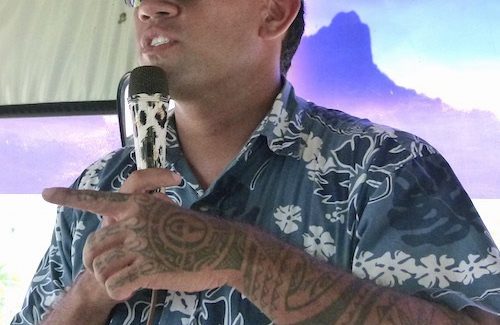Seeing a revival of traditional Tahitian tattoos
Tour guide Teiva moved over, thinking he was blocking my picture. But he was my picture.
The tattoos on his arm and neck were fascinating. When I told Teiva I would like to photograph them and learn more about the art, Teiva was happy to oblige.
“These are in honor of my family and my heritage,” he said, gesturing to the designs on his left arm, hand and fingers. A shark tattooed on his arm and an eel on his neck are “the protectors for my family.”
Polynesians pretty much invented the form of body art, Teiva said. “The word ‘tattoo’ comes from the Tahitian word ‘tatau,’ which means ‘to strike.’ That is how tattoos used to be done and are still done by some artists today.”
Traditional Tahitian tattoos were made by using a comb with teeth of sharpened bone, shell, shark’s teeth or wood. Using anywhere from three to 20 teeth, the teeth would be dipped into natural black ink and tapped into the skin with a wooden stick. The black ink was made from the soot of burnt candlenut mixed with water or oil.
It often would take two people to do a tattoo – one to hold the skin taut and one to do the tattoo. Tatau or tattooing with traditional tools was banned in 1986 by the Ministry of Health because of the difficulty in sterilizing the wood and bone equipment which increased the risk of spreading disease. It was allowed again in 2001 with one-time-use tools. Those tools often are given as a souvenir to the person getting the tattoo.
To continue their art, some tattoo artists began using disposable steel needles. Although many tattoo parlors now use tattoo guns, some tattoo artists still use the traditional method.
Considered a sign of beauty in the Polynesian culture, teenagers used to be ceremoniously tattooed once they reached adolescence, Teiva said. “The tattoos told a story. They were very important so you were carful in choosing what your tattoos would be.”
The art of tattoos goes back as far as 1500 BC. Nearly everyone was tattooed in ancient Polynesia and each tattoo was considered far more than a body ornament. It symbolized a person’s genealogy and rank in society as well as exploits successfully undertaken by the person. That’s why chiefs and warriors usually had the most elaborate tattoos.
When Europeans came to Polynesia, they were astounded by the body art. The first navigator trying to explore the whole Polynesian Triangle, Captain James Cook wrote in his diary “they print signs on people’s body and call this tattow.”
The naturalist aboard Cook’s ship HMS Endeavor, Joseph Banks wrote in his journal: “I shall now mention the way they mark themselves, indelibly, each of them is so marked by their humor or dispositions.”
Native Tahitian Omain became a sensation when he appeared in Europe because of his tattoos. Sailors stopping in Tahiti were soon baring their arms for a souvenir tattoo which may account for the traditional sailor tattoos.
In mythology, the two sons of the god Ta’aroa – Mata Arhu and Tu Ra’I po’ – liked the art and decided to teach it to humans. The two sons are now the patron divinities of tattoo. Not only were tattoos used for social purposes but they were also considered protection against evil spirits.
When missionaries arrived in Tahiti in the 18th century, they considered tattoos a sinful glorification of the flesh and banned the art. But, starting in the 1980s, Tahitian tattoos have enjoyed a renaissance.
Most of the tattoos I have seen on the islands during my cruise feature intricate curvy little designs. “Those are hard to do,” Teiva said, pointing to the circular patterns on his arm.
Even Hollywood is taking note of revived Polynesian tattoos. In the 2016 Disney movie “Moana,” the Polynesian demigod who accompanies the heroine girl on her journey is a physically imposing character named Maui with a wild mane of hair and a body of intricate tattoos.
Maui’s tattoos are like a scrapbook of his great exploits. Reportedly, a crew of folks visited Polynesian islands to get the culture and the tattoos correct.
Voiced by Dwayne “The Rock” Johnson, Maui is a big departure from how such Polynesian movie characters may have been portrayed in the past. Tattoos would have been taboo and here is Disney showing them as a proud fact of life. There is even a scene in the movie showing the traditional art of tattooing.
“The Rock” himself is familiar with tattoos. Half Samoan, he had his family history inked on his chest, shoulder and arm in 2003. For the 60-hour process, he chose a famous Moorea island tattoo artist, Po’oino Yrondi.
Ah, the surprising things you can learn on a cruise.















View Recent Comments